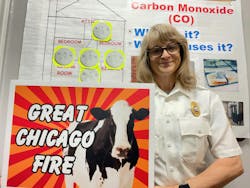Take a Look Back: Moving Forward to Teach Fire Prevention
Whether a department is located in a small town or a major city, the COVID-19 pandemic hit fire prevention activities the same. The fire prevention message outreach was disrupted. How would this affect the thoughtful reinforcement and retention of information that usually only is provided once per year? Could departments simply pick up where they were before the pandemic and continue the transfer of information among their most vulnerable population: younger, school-age children?
Our goal as fire prevention educators has and always will be to positively reinforce situational awareness regarding fire prevention and safety, to impulsively and spontaneously react to a fire situation or event to produce the favorable outcome of survival. Beginning and continuing this education as early as possible helps to instill skills that are hoped to be carried through to adolescence, adulthood and into senescence.
Self-analysis
Before I returned to the school system educational bully pulpit after my two-year COVID-19 hiatus, I decided to do a little self-reflecting, in particular, concentrating on a review of my teaching style and methodology. Could I do better transferring my message?
The first question that I asked myself was, “Am I a good teacher?” Do I present information in a way that’s understandable to my audience? Do I translate my knowledge by speaking to the age and mental retention level of the audience? Do I feel the connection?
To help you to answer some of these questions and to evaluate the effect of your presentations, take yourself back to grade school, high school or college. Did you have a favorite teacher? One who is rememberable even to this day? What attracted you to that teacher? What made that person notable and unforgettable? Do you see those same unforgettable, notable qualities in yourself? Are you projecting those same qualities to make you and your program unforgettable to your audiences?
Do you present with charisma that generates excitement? Are you fun, entertaining and relatable?
The typical fire educator doesn’t have a year or a semester to become influential to students. We are challenged by presenting in no more than 45 minutes once per year to impress upon the impressionable how to save their life or the life of another. We ask children to recall the lessons that we attempted to instill a year or more ago. We are challenged further by the teaching of information that might never be used for an event that might never happen. Will the cognitive recall be there?
I decided during my self-analyzation to reassess my enthusiasm and passion for the fire prevention subject matter and to polish my teaching style.
Just because you exhibit a reputation of robust passion and dedication to fire prevention and are considered an expert in your circle of cohorts and peers doesn’t mean that you are getting your message through to an audience of varying ages and mental states of mind. If you can’t transfer that message and connect to your audience, you fail as an educator.
Technology
To aide us, the fire service has integrated technology into fire education presentations by utilizing PowerPoint, YouTube and other such mediums. However, by utilizing these forms of technology, is our message getting through effectively?
I have been in the fire service for more than 30 years and, for the most part, utilized the same teaching methods. One year, I thought that I might be doing a disservice by not utilizing these “newer” teaching aides into my program. I presented a fire safety YouTube video to third- and fourth-grade audiences. The reception was lackluster. Halfway through the 16-minute video, the children lost attention and began to squirm and fidget, and with the lights dimmed, they were falling asleep.
If there is a loss of attention, the message doesn’t get through, let alone retained. Utilizing this method just wasn’t for me. I stayed with the tried and true: me and my town’s firefighters. I present the information I want (e.g., smoke detectors, CO alarms, EDITH, etc.), utilizing the teaching methods and style that I chose.
Humor
Using humor can help to keep young children fully engaged. You aren’t a comedian? No problem. Neither am I. Sometimes, the unexpected of happenstances can be an enormous, unplanned teaching moment.
I readjusted my teaching style to include some old teaching props. Using my flip chart—yes, a flip chart—my firefighter co-presenter and I began to instruct on where smoke detectors should be placed in the home. We placed the smoke detector pictures on the board. One fell off. The kids giggled. The firefighter picked it up and placed it back on the board. As he turned to face the audience, it fell again. The kids pointed and laughed. He placed more tape on it and asked whether one of the children could help him place it back on the board. We chose a student. The others cheered their classmate as he placed it in the correct location, and it stayed on the board.
This moment wasn’t planned, but it provided an invaluable connection between us and the audience. It was relatable, it was real, and, most importantly, the kids enjoyed it. I felt the connection.
Direct and intentional
Being a “seasoned” fire prevention educator can be challenging when working with younger firefighting personnel. My teaching methods aren’t necessarily what they perceive as contemporary.
To begin my program with the younger school grades, I usually start with one of my old-school tactics, the story of why we recognize fire prevention week. I begin by using my 16 story boards to tell the story of the Great Chicago fire.
Typically, when I hand my much younger firefighting colleague the story boards, they are received by third-grade students with a collective eye roll. However, I know from the results of past presentations to this audience grade that the presentation would be a winner. During my most recent presentation to third graders, along came the same collective eye roll. I proceeded. The children were captivated, and there was laughter at the end.
Next, it came time for the fourth-grade presentation. Students came into the room and took their seats. I introduced myself and the firefighters who were helping me. Before I even began my presentation, one child asked whether I was going to tell “the story.” I said, “I wasn’t. I thought all of you are too old for that?” I saw disappointment on their faces, so I asked the entire audience, “Do you want to hear ‘the story?’” I received a resounding, “Yes!”
The Great Chicago Fire story was enjoyed by that age group just as much as it was by the students in the lower grades. I felt the connection. I had them for the rest of the presentation.
Presenting in this manner, with direct and intentional interaction, reminded me of a famous quote that I think about when I design any program: “Tell me and I forget, teach me and I may remember, involve me and I learn.” Stated by Benjamin Franklin, he got it right.
‘After the Fire’
Humor isn’t needed to get your teaching points across to a specific audience demographic all of the time. That said, don’t be afraid to expand your teaching modalities outside of the box. Each age group has its own comprehension and retention issues.
One presentation that truly is tailored for an age group range is “After the Fire.” It’s a powerful video lecture that’s given by two survivors of the Jan. 19, 2000, Seton Hall University dormitory fire. Alvaro Llanos and Shawn Simons tell an amazing story of “survival, perseverance and inspiration, hope and courage.” It truly is a remarkable documentary and one to be considered to capture that difficult-to-reach, college-bound age group of high schoolers.
Do you feel the connection?
Back inside of the classroom for two years now, to my surprise, the kids didn’t miss a beat. I credit this to my no-frills program that reiterates a consistent message via old-school teaching methods.
It’s OK to challenge technology, to utilize your tried-and-true teaching methods. That said, don’t be afraid to alter or to try something new.
Not sure if your presentations are working? Ask yourself, “Do I feel the connection?”
About the Author

Tracy Kilmer
Tracy Kilmer has been the fire official in the borough of Palmyra, NJ, for 28 years, conducting fire inspections and investigations. She also is the borough’s construction official and fire subcode official as well as an EMT with Cinnaminson Fire Department in Burlington County, NJ. Kilmer holds New Jersey Division of Fire Safety certifications as Fire Official, Firefighter 2, Hazmat On-Scene Commander, Incident Management System Level I and Instructor Level II. She holds New Jersey Department of Community Affairs licenses as a construction official, a high-rise/hazardous (HHS) fire inspector, a subcode official: fire protection and a housing official/inspector, among others. Kilmer served for 10 years as a structural firefighter and is a past instructor at the Burlington County Fire Academy. She holds an associate degree in law enforcement.
